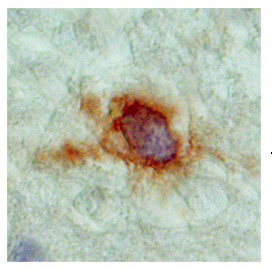SLC18A2 antibody - N-terminal region
Rabbit Polyclonal Antibody
- SPECIFICATION
- CITATIONS
- PROTOCOLS
- BACKGROUND

Application
| WB, IHC |
|---|---|
| Primary Accession | Q05940 |
| Other Accession | NM_003054, NP_003045 |
| Reactivity | Human, Mouse, Rat, Rabbit, Pig, Horse, Bovine, Guinea Pig, Dog |
| Predicted | Human, Mouse, Rabbit, Chicken, Horse, Bovine, Dog |
| Host | Rabbit |
| Clonality | Polyclonal |
| Calculated MW | 56kDa |
| Gene ID | 6571 |
|---|---|
| Alias Symbol | MGC120477, MGC120478, MGC26538, SVAT, SVMT, VAT2, VMAT2 |
| Other Names | Synaptic vesicular amine transporter, Monoamine transporter, Solute carrier family 18 member 2, Vesicular amine transporter 2, VAT2, SLC18A2, SVMT, VMAT2 |
| Format | Liquid. Purified antibody supplied in 1x PBS buffer with 0.09% (w/v) sodium azide and 2% sucrose. |
| Reconstitution & Storage | Add 50 ul of distilled water. Final anti-SLC18A2 antibody concentration is 1 mg/ml in PBS buffer with 2% sucrose. For longer periods of storage, store at 20°C. Avoid repeat freeze-thaw cycles. |
| Precautions | SLC18A2 antibody - N-terminal region is for research use only and not for use in diagnostic or therapeutic procedures. |
| Name | SLC18A2 |
|---|---|
| Synonyms | SVMT, VMAT2 |
| Function | Electrogenic antiporter that exchanges one cationic monoamine with two intravesicular protons across the membrane of secretory and synaptic vesicles. Uses the electrochemical proton gradient established by the V-type proton-pump ATPase to accumulate high concentrations of monoamines inside the vesicles prior to their release via exocytosis. Transports a variety of catecholamines such as dopamine, adrenaline and noradrenaline, histamine, and indolamines such as serotonin (PubMed:23363473, PubMed:37914936, PubMed:38081299, PubMed:38517752, PubMed:8643547). Regulates the transvesicular monoaminergic gradient that determines the quantal size. Mediates somatodendritic dopamine release in hippocampal neurons, likely as part of a regulated secretory pathway that integrates retrograde synaptic signals (By similarity). Acts as a primary transporter for striatal dopamine loading ensuring impulse-dependent release of dopamine at the synaptic cleft (By similarity). Responsible for histamine and serotonin storage and subsequent corelease from mast cell granules (PubMed:8860238). |
| Cellular Location | Cytoplasmic vesicle, secretory vesicle, synaptic vesicle membrane {ECO:0000250|UniProtKB:Q01827}; Multi-pass membrane protein. Cytoplasmic vesicle, secretory vesicle membrane {ECO:0000250|UniProtKB:Q01827}; Multi-pass membrane protein. Cell projection, axon {ECO:0000250|UniProtKB:Q01827} Cell projection, dendrite {ECO:0000250|UniProtKB:Q01827}. Note=Sorted to large dense core granules in neuroendocrine cells, presumably at the level of the trans-Golgi network. In neurons it is predominantly detected in somatodendritic tubulovesicular membranes, a distinct population of secretory vesicles that undergo calcium-dependent exocytosis in axons and dendrites upon depolarization. Localized at synaptic vesicles in axons. {ECO:0000250|UniProtKB:Q01827} |
| Tissue Location | Expressed in neuronal and neuroendocrine tissues. Detected in central and peripheral nervous system in particular in axonal and dendritic processes in dopaminergic cells of substantia nigra, histaminergic neuronal cell bodies of substantia nigra and tuberomammillary nucleus, in ganglion cells of sympathetic glia and in peripheral sympathetic nerve terminals in stomach and duodenum (at protein level). Highly expressed in chromaffin cells of the adrenal medulla and histamine-storing enterochromaffin-like cells of oxyntic mucosa (at protein level). |

Thousands of laboratories across the world have published research that depended on the performance of antibodies from Abcepta to advance their research. Check out links to articles that cite our products in major peer-reviewed journals, organized by research category.
info@abcepta.com, and receive a free "I Love Antibodies" mug.
Provided below are standard protocols that you may find useful for product applications.
References
Yamamoto,S.,(2006)Neurosci.Lett.396(3),187-191ReconstitutionandStorage:Forshorttermuse,storeat2-8Cupto1week.Forlongtermstorage,storeat-20Cinsmallaliquotstopreventfreeze-thawcycles.
If you have used an Abcepta product and would like to share how it has performed, please click on the "Submit Review" button and provide the requested information. Our staff will examine and post your review and contact you if needed.
If you have any additional inquiries please email technical services at tech@abcepta.com.













 Foundational characteristics of cancer include proliferation, angiogenesis, migration, evasion of apoptosis, and cellular immortality. Find key markers for these cellular processes and antibodies to detect them.
Foundational characteristics of cancer include proliferation, angiogenesis, migration, evasion of apoptosis, and cellular immortality. Find key markers for these cellular processes and antibodies to detect them. The SUMOplot™ Analysis Program predicts and scores sumoylation sites in your protein. SUMOylation is a post-translational modification involved in various cellular processes, such as nuclear-cytosolic transport, transcriptional regulation, apoptosis, protein stability, response to stress, and progression through the cell cycle.
The SUMOplot™ Analysis Program predicts and scores sumoylation sites in your protein. SUMOylation is a post-translational modification involved in various cellular processes, such as nuclear-cytosolic transport, transcriptional regulation, apoptosis, protein stability, response to stress, and progression through the cell cycle. The Autophagy Receptor Motif Plotter predicts and scores autophagy receptor binding sites in your protein. Identifying proteins connected to this pathway is critical to understanding the role of autophagy in physiological as well as pathological processes such as development, differentiation, neurodegenerative diseases, stress, infection, and cancer.
The Autophagy Receptor Motif Plotter predicts and scores autophagy receptor binding sites in your protein. Identifying proteins connected to this pathway is critical to understanding the role of autophagy in physiological as well as pathological processes such as development, differentiation, neurodegenerative diseases, stress, infection, and cancer.


